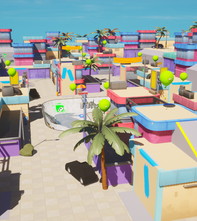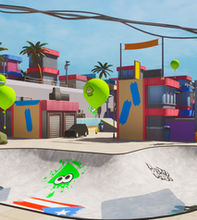
Splatoon: 'La Perla's Bowl'
Level design solo project made in Unreal Engine 5, inspired by the popular game Splatoon. It began as a simple Level Design Jam level and evolved into an arcade time-score experience. 'La Perla's Bowl' draws inspiration from the picturesque environment of La Perla in San Juan, Puerto Rico.
To see the full gameplay video, click here!
Level gameplay from famous streamer JayMoji!
(Starts at minute 1:32)
Click the images to get a better view!
Goal:
-
Craft an experience very similar to what the game offers while applying pivotal-level design concepts, taking multiple aspects of its fun gameplay, and incorporating some of my own design choices in gameplay.
Project Details:
-
ENGINE: Unreal Engine 5
-
LANGUAGE: Blueprints
-
DURATION: 3-4 Weeks
-
TEAM SIZE: Solo project
Learnings:
1. Use of height and elevated spaces
2. Designing engaging combat spaces using low and high covers
3. Music and SFXs implementation to create an immersive experience
4. Design and prototype gameplay mechanics to create an experience very similar to Splatoon
5. Material and Shader creation for UI widgets and gameplay mechanics
Assets Used:
-
Stylized Cyberpunk City Props (Art)
-
Shanty Town Slums (Art)
-
POLYGON - Prototype Pack (Art)
-
Good Sky (Art)
-
FX Variety Pack (Art)
-
Multiple assets from Sketchfab (Art)
Level Design Process
Welcome to my Splatoon-inspired level design project in Unreal Engine 5! For the design of this map, my primary goal was to highlight key concepts commonly used in multiplayer maps. I also wanted to replicate some of the game mechanics to offer players a more realistic experience. To add my design touch, I introduced an arcade time-score system, enhancing replayability for the players.
The idea of the project began when I decided to participate in a Level Design Jam called: Krak Dev-Level Design, during the months of June and July of 2023. That simple Level Design Jam level evolved into an arcade time-score experience!
To see a specific topic of the design process, click on one of the sections below:
Research and Design Ideas
This moodboard showcases all the reference images I used to design the environment, along with the Level Design document.

Paper Designs
These were the paper designs I initially sketched to determine the player paths, spawn points, and choke points. It served as an initial idea to start building the map
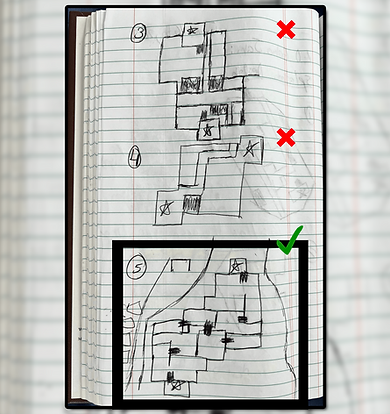
I began by sketching multiple ideas, aiming for a symmetrical design. Additionally, I am showcasing some of the discarded level sketches I made before choosing the current one.
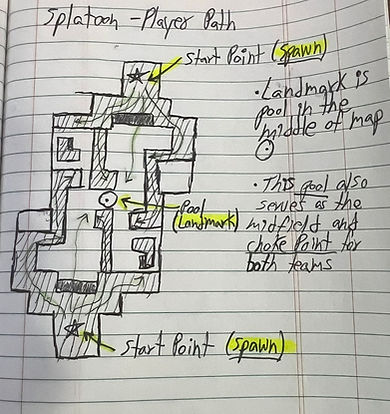
Once I had a clear idea of the map design and what I wanted, I began establishing choke points, player spawn points, and defining player paths around the map.
Layout and Development
During the blockout phase, I translated the initial sketches into a tangible and playable map. The sketches, inspired by Splatoon's Turf War mode, laid the foundation for the map layout. I focused on incorporating multiple elevations, allowing strategic gameplay dynamics. Depending on the player's height level, they would receive different points when painting the floors. Symmetry was a key consideration here, ensuring balance and fairness for both sides of the map while aligning with Splatoon's competitive nature.
Three key components to enhance player navigation were:
-
Rooftop Routes: These pathways offer players alternative routes and strategic options for traversal. Accessible through ramps and elevated areas, they encourage dynamic and tactical movement across the level.
-
Bowl Pool: Serving as the map's central landmark, the Bowl Pool not only anchors the level but also functions as a dynamic focal point for strategic control in the midfield zone. This element helps preserve the vibrant essence of 'La Perla.'
-
Colorful Houses: These structures were strategically placed to not only create a visually captivating environment but also serve as a backdrop, defining the map's boundaries
Each of these components was carefully integrated into the blockout phase, serving as fundamental elements in crafting an engaging and visually appealing Splatoon level.
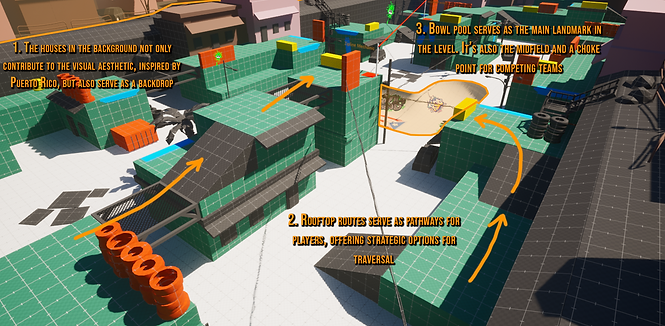

Initial character metric to start building the map. Check out my analysis here for more details on this


Initial blockout process, from the sketch idea to the final blockout iteration


Blue paint on building walls serves as affordances for the player's swimming mechanic
After multiple iterations, the map was playable and ready to be used for the Turf War game mode with multiple teams and players. However, I wanted to give it my design touch and incorporate the remaining Splatoon gameplay mechanics. I decided to add the 'balloon time score mode,' drawing inspiration from the game's Tutorial stage.
With the level design completed, my focus shifted to faithfully replicating Splatoon's character movement. To achieve this, extensive research was necessary. Initially, I used Unreal Engine's Third-Person Character Controller template as a foundation. I fine-tuned elements such as jump height and implemented a new Animation Blueprint. Through Mixamo, I found a variety of animations covering all player directions, seamlessly integrating them into the Blueprint. This process significantly enhanced the overall movement feel.

Testing the shooting mechanic and the character movement
After finishing the character movement, my focus shifted to the shooting/paint mechanic, and this is where the real challenge began. I designed a simple projectile system with two color variations that spawn when the player shoots, accompanied by all the necessary VFXs, feedback, and sound cues. What adds an intriguing layer to this mechanic is the versatility of its implementation. There were numerous approaches I could've used, but for my specific goals and what I wanted, I opted for the use of decals.
For this, I used as a reference the Plaintsplat projectile made by Andreas Glad. Using the decal method eliminates the need to use Render Targets or Heightmaps. Also, after a certain amount of time, I could just fade the decal and destroy the actor, in a seamless process.


Blue and yellow teams Ink projectiles
After finalizing the projectiles, I focused on creating a 'liquid effect' that could dynamically interact with both the player's movements and the environment. I made a material that brought this 'liquid' element to life, using as a reference Lush VFX's comprehensive VFX analysis of his Splatoon project. This material was applied to the Ink Tank on the player's back, making it react dynamically with the environment.
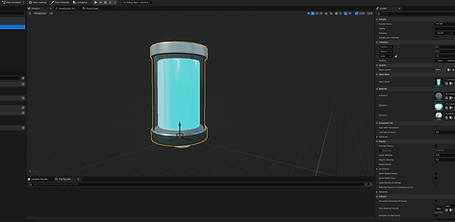
Ink Tank BP used for the character

Liquid Lush material used for the Ink Tank
The final mechanic I wanted to incorporate into the character controller was the swimming mechanic. To achieve this, I implemented a series of actions:
-
Scaling down the player to the floor using a Timeline Blueprint node.
-
Introduced multiple VFXs, and sound cues.
-
Increased the character's movement speed.
-
Seamlessly transition to the squid form by toggling the visibility of the squid mesh while turning off the character mesh.
The most challenging aspect of this implementation was to make sure it seamlessly blended with the other feedback used. When all these elements come together, it closely resembles the fluidity of the swimming mechanic used in Splatoon.
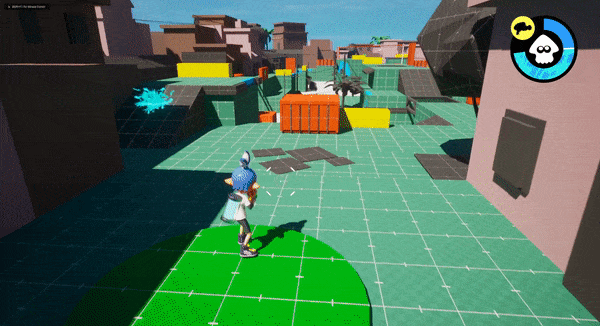
First iteration of the swimming mechanic

Character BP with all the tweaks and mechanics added
With the character mechanics now finalized, my focus shifted to making the last adjustments to the map itself. This involved replacing the blockout assets with the final models and scripting the balloon time score mode I wanted for the gameplay.
For this score mode, I scripted a simple timer and a screen counter that dynamically adjusts based on the number of balloons available. As players pop balloons, the game mode keeps track of the remaining count and updates an integer variable accordingly. This dynamic element adds an engaging layer of gameplay, enhancing the overall player experience.
These were some of the character assets I used from Sketchfab: the inkling boy main character, splatoon gun, the balloons, and the character squid form.

A before and after slider of the level environment
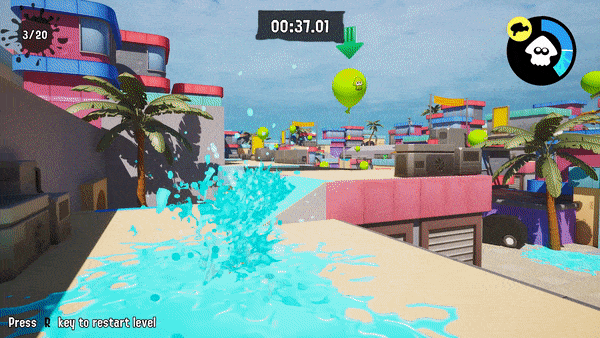
Finalized gameplay with the final level assets implemented
Iterations
During the design of the map, I encountered several significant challenges that forced me to adapt my approach to level design and gameplay implementation.
For the shooting/paint mechanic, my initial plan was to add the heightmap paint technique shown by Mix and Jam in his Splatoon ink system video. This technique was cleaner and offered more visually appealing results. However, due to its complexity, I opted for the decal technique to streamline development.
Similar challenges appeared with the wall swimming traversal mechanic. While I was excited about implementing it, time constraints and the complexity involved led me to pivot towards a simpler teleportation prototype mechanic. This prototype offered a glimpse of what the mechanic could have been like if fully implemented.
I also noticed a limited number of resources, on YouTube and around the web, regarding Splatoon mechanics and the specific ideas I aimed to incorporate from the start. This scarcity prompted me to think creatively and develop alternative solutions that not only worked but also maintained a cool and presentable visual aspect.
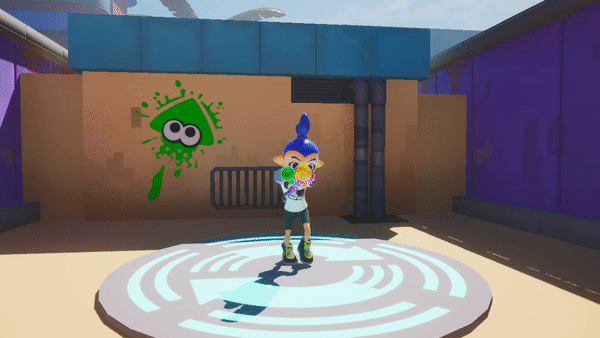
Conclusion
The development of this Splatoon-inspired level was a challenging yet educational experience. Over several weeks, I faced various obstacles, including venturing into multiplayer map creation, dealing with symmetrical design intricacies, and adapting gameplay mechanics to meet my vision within tight time constraints.
These obstacles served as invaluable teachers, compelling me to think creatively and develop alternative solutions that not only addressed the challenges at hand but also maintained a high standard of visual and functional quality.
This project not only allowed me to delve into the technical aspects of programming and design, which I had never explored in-depth before, but it also honed my skills in research, creative thinking, and adapting to unforeseen circumstances.
In conclusion, creating this prototype was not just about developing a playable level, but it was a journey of growth and exploration within game design. I thoroughly enjoyed the process and look forward to applying everything I've learned in future projects.
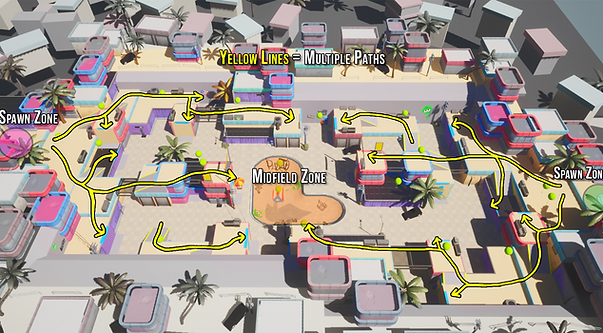
Final level design map path with some of the design concepts used while making the blockout


